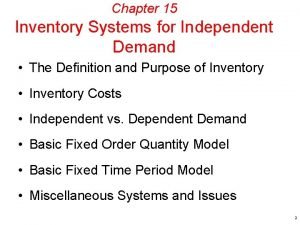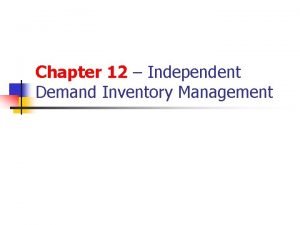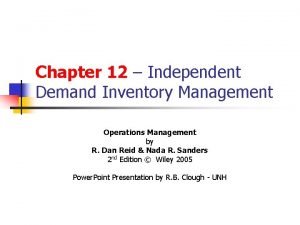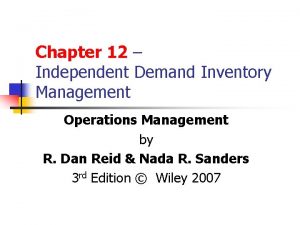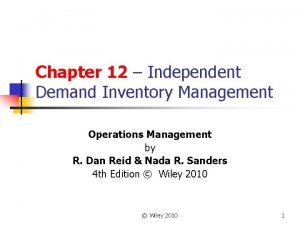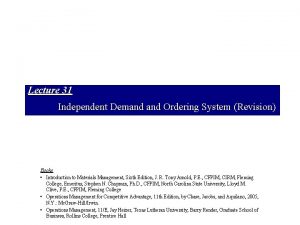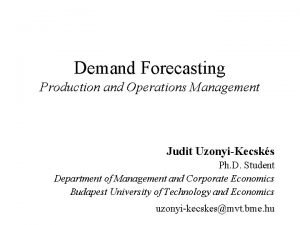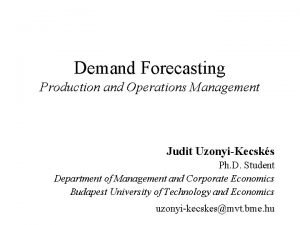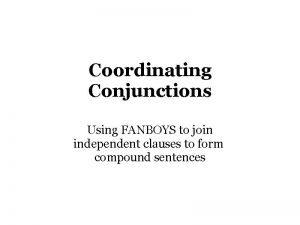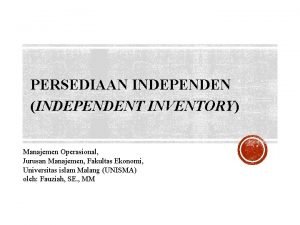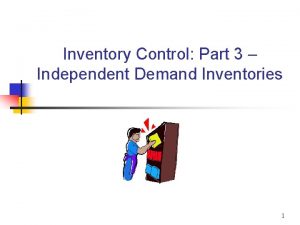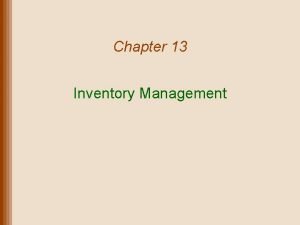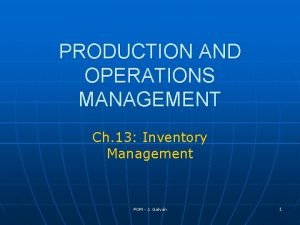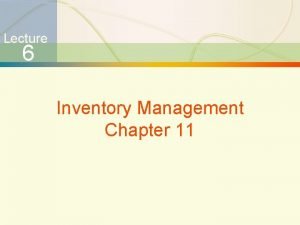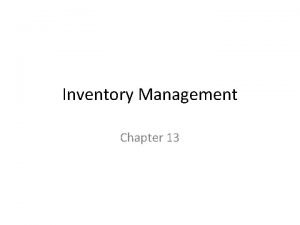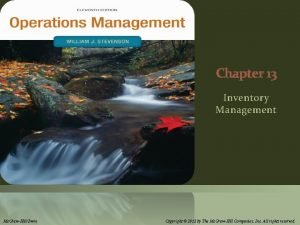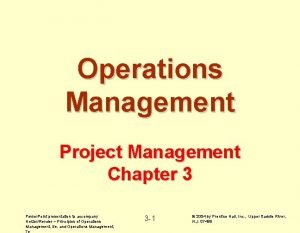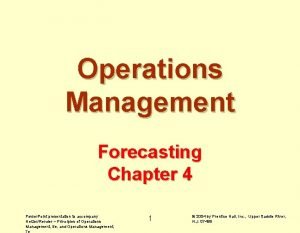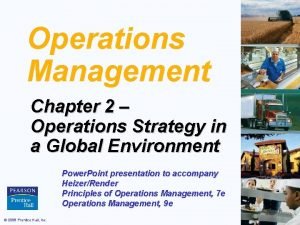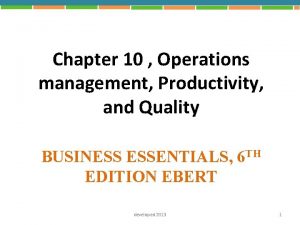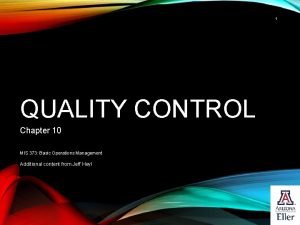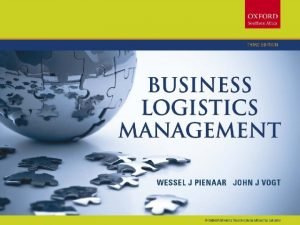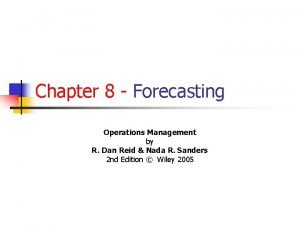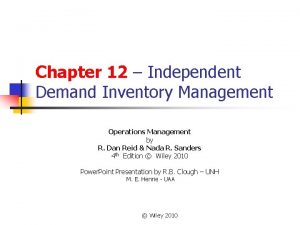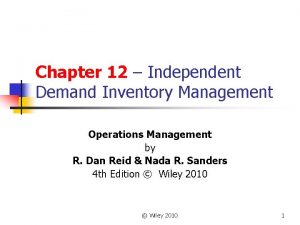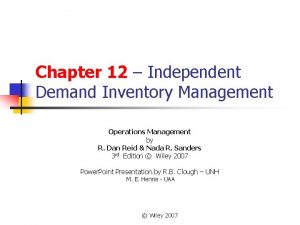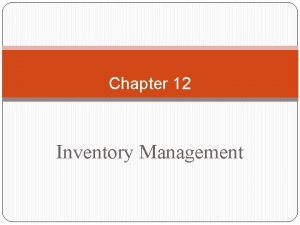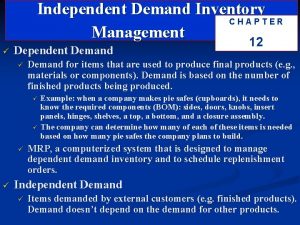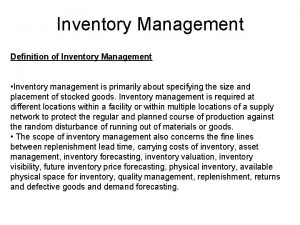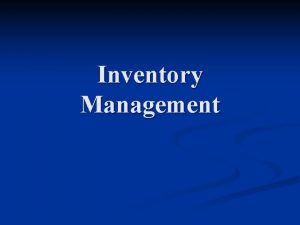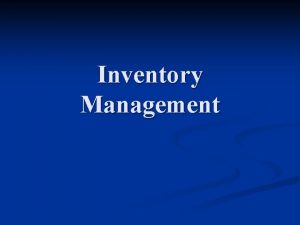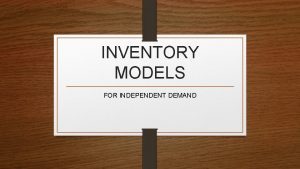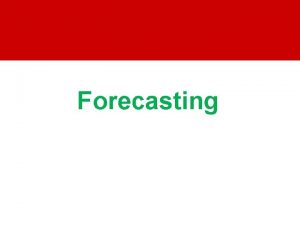Chapter 12 Independent Demand Inventory Management Operations Management






































- Slides: 38

Chapter 12 – Independent Demand Inventory Management Operations Management by R. Dan Reid & Nada R. Sanders 2 nd Edition © Wiley 2005 Power. Point Presentation by R. B. Clough - UNH

Inventories in the Supply Chain

Independent vs. Dependent Demand n n Independent demand items are finished goods or other items sold to someone outside the company Dependent demand items are materials or component parts used in the production of another item (e. g. , finished product)

Types of Inventory: How Inventory is Used n n n Anticipation or seasonal inventory Safety stock: buffer demand fluctuations Lot-size or cycle stock: take advantage of quantity discounts or purchasing efficiencies Pipeline or transportation inventory Speculative or hedge inventory protects against some future event, e. g. labor strike Maintenance, repair, and operating (MRO) inventories

Objectives of Inventory Management n n n Provide acceptable level of customer service (on-time delivery) Allow cost-efficient operations Minimize inventory investment

Relevant Inventory Costs Item Cost per item plus any other direct costs associated with getting the item to the plant Holding Costs Capital, storage, and risk cost typically stated as a % of the unit value, e. g. 15 -25% Ordering Cost Fixed, constant dollar amount incurred for each order placed Shortage Costs Loss of customer goodwill, back order handling, and lost sales

Order Quantity Strategies Lot-for-lot Order exactly what is needed for the next period Fixed-order Order a predetermined amount each quantity time an order is placed Min-max system Order n periods When on-hand inventory falls below a predetermined minimum level, order enough to refill up to maximum level Order enough to satisfy demand for the next n periods

Examples of Ordering Approaches

Three Mathematical Models for Determining Order Quantity n Economic Order Quantity (EOQ or Q System) n n n Economic Production Quantity (EPQ) n n An optimizing method used for determining order quantity and reorder points Part of continuous review system which tracks onhand inventory each time a withdrawal is made A model that allows for incremental product delivery Quantity Discount Model n Modifies the EOQ process to consider cases where quantity discounts are available

Economic Order Quantity n EOQ Assumptions: n n n Demand is known & constant no safety stock is required Lead time is known & constant No quantity discounts are available Ordering (or setup) costs are constant All demand is satisfied (no shortages) The order quantity arrives in a single shipment

EOQ: Total Cost Equation

EOQ Total Costs Total annual costs = annual ordering costs + annual holding costs

The EOQ Formula Minimize the TC by ordering the EOQ:

When to Order: The Reorder Point n Without safety stock: n With safety stock:

EOQ Example n n n Weekly demand = 240 units No. of weeks per year = 52 Ordering cost = $50 Unit cost = $15 Annual carrying charge = 20% Lead time = 2 weeks

EOQ Example Solution

EPQ (Economic Production Quantity) Assumptions n Same as the EOQ except: inventory arrives in increments & is drawn down as it arrives

EPQ Equations n Adjusted total cost: n Maximum inventory: n Adjusted order quantity:

EPQ Example n n n Annual demand = 18, 000 units Production rate = 2500 units/month Setup cost = $800 Annual holding cost = $18 per unit Lead time = 5 days No. of operating days per month = 20

EPQ Example Solution

EPQ Example Solution (cont. ) n The reorder point: n With safety stock of 200 units:

Quantity Discount Model Assumptions n Same as the EOQ, except: n n Unit price depends upon the quantity ordered Adjusted total cost equation:

Quantity Discount Procedure n n Calculate the EOQ at the lowest price Determine whether the EOQ is feasible at that price n n Will the vendor sell that quantity at that price? If yes, stop – if no, continue Check the feasibility of EOQ at the next higher price Continue to the next slide. . .

QD Procedure n n n (continued) Continue until you identify a feasible EOQ Calculate the total costs (including total item cost) for the feasible EOQ model Calculate the total costs of buying at the minimum quantity required for each of the cheaper unit prices Compare the total cost of each option & choose the lowest cost alternative Any other issues to consider?

QD Example n n Annual Demand = 5000 units Ordering cost = $49 Annual carrying charge = 20% Unit price schedule:

QD Example Solution n Step 1

QD Example Solution (Cont. ) n Step 2

What if Demand is Uncertain?

Safety Stock and Service Level n n n Order-cycle service level is the probability that demand during lead time won’t exceed on-hand inventory. Risk of a stockout = 1 – (service level) More safety stock means greater service level and smaller risk of stockout

Safety Stock and Reorder Point n Without safety stock: n With safety stock:

Reorder Point Determination R = reorder point d = average daily demand L = lead time in days z = number of standard deviations associated with desired service level s = standard deviation of demand during lead time

Safety Stock Example Daily demand = 20 units n Lead time = 10 days n S. D. of lead time demand = 50 units n Service level = 90% Determine: 1. Safety stock 2. Reorder point n

Safety Stock Solution Step 1 – determine z Step 2 – determine safety stock Step 3 – determine reorder point


ABC Inventory Classification n n ABC classification is a method for determining level of control and frequency of review of inventory items A Pareto analysis can be done to segment items into value categories depending on annual dollar volume A Items – typically 20% of the items accounting for 80% of the inventory value-use Q system B Items – typically an additional 30% of the items accounting for 15% of the inventory value-use Q or P C Items – Typically the remaining 50% of the items accounting for only 5% of the inventory value-use P

ABC Example: the table below shows a solution to an ABC analysis. The information that is required to do the analysis is: Item #, Unit $ Value, and Annual Unit Usage. The analysis requires a calculation of Annual Usage $ and sorting that column from highest to lowest $ value, calculating the cumulative annual $ volume, and grouping into typical ABC classifications.

Inventory Record Accuracy n Inaccurate inventory records can cause: n n n Lost sales Disrupted operations Poor customer service Lower productivity Planning errors and expediting Two methods are available for checking record accuracy n n Periodic counting-physical inventory Cycle counting-daily counting of pre-specified items provides the following advantages: n n n Timely detection and correction of inaccurate records Elimination of lost production time due to unexpected stock outs Structured approach using employees trained in cycle counting

Chapter 12 HW Assignment Problems 6, 7, 9 – 13, 16, 17, 22 – 24.
 Independent vs dependent demand
Independent vs dependent demand Example of independent demand
Example of independent demand Independent demand definition
Independent demand definition Independent demand examples
Independent demand examples Inventory planning for independent demand items
Inventory planning for independent demand items Independent demand meaning
Independent demand meaning Total cost formula
Total cost formula Operations management chapter 12 inventory management
Operations management chapter 12 inventory management Inventory models for independent demand
Inventory models for independent demand Inventory models for independent demand
Inventory models for independent demand Demand service
Demand service Demand forecasting in operations management
Demand forecasting in operations management Demand forecasting in operations management
Demand forecasting in operations management Independent clause fanboys independent clause
Independent clause fanboys independent clause Multi step income statement pearson
Multi step income statement pearson Rumus eoq dan epq
Rumus eoq dan epq Independent demand meaning
Independent demand meaning Inventory modeling
Inventory modeling Measures to correct excess and deficient demand
Measures to correct excess and deficient demand Market demand curve
Market demand curve Halimbawa ng iskedyul ng demand
Halimbawa ng iskedyul ng demand Module 5 supply and demand introduction and demand
Module 5 supply and demand introduction and demand Demand estimation and forecasting in managerial economics
Demand estimation and forecasting in managerial economics Distinguish between individual demand and market demand
Distinguish between individual demand and market demand S&op sap
S&op sap Chapter 13 inventory management problems and solutions
Chapter 13 inventory management problems and solutions Chapter 13 inventory management problems and solutions
Chapter 13 inventory management problems and solutions Chapter 13 inventory management
Chapter 13 inventory management Chapter 13 inventory management
Chapter 13 inventory management Chapter 13 inventory management
Chapter 13 inventory management Operations management chapter 3 ppt
Operations management chapter 3 ppt Operations management chapter 4 forecasting solutions
Operations management chapter 4 forecasting solutions Operations management chapter 2
Operations management chapter 2 Operation management objectives
Operation management objectives Product selection and design in operations management
Product selection and design in operations management Operations management chapter 10
Operations management chapter 10 Asq control chart
Asq control chart Chapter 8 operations management
Chapter 8 operations management Forecasting in operations management
Forecasting in operations management



